3D Printers & Fabbers
Have you ever had a really good idea for a product but you weren't sure how to go about designing or developing it? Today's technology lets you do it within a day! If you have an idea for a product all you need to do is draw it using computer software, print it out in 3D, and test it – all within the same day! It's possible! Printing three-dimensional objects is not new. Rapid prototyping machines have been around since the 1980s1 and since 2010 one new type of these three-dimensional printers has successfully "bioprinted" a blood vessel (video)!2,3,4 Cornell University and the French Culinary Institute combined efforts and created a 3-D food printer that can print messages in cakes, or print out edible, bite-sized space shuttles.5,6,7 This technology may soon be found in homes everywhere!8 The going price of food printers is under $1000. Personal manufacturing machines, known as "fabbers," cost from $800 to $3000. Commercial printers range from $10 thousand to $500 thousand. Read on to learn some of the common physics behind these machines.
This short video shows the printing of a tool with movable parts.9
Features of 3-D printing
The latest 3-D printers are printing very different items but they have some common features. They require a way to input the printing specifications electronically of the object to be constructed, and they require a medium or "ink" that is printed in successive layers to construct a 3-D object. Some systems need a material in which the "ink" is sprayed onto or into, layer-by-layer. When a real object is being copied a laser scanner is used to scan the original object and an electronic version is created from the scan. The latest is a build-it-yourself (blue prints are downloadable), open source software, at home fabrication machine.10-13 To learn about the build-it-yourself at home fabber machine watch this Popular Mechanics video.11
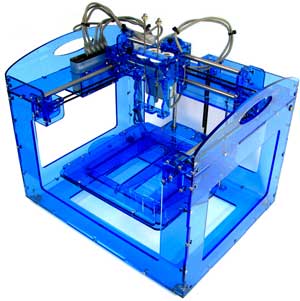 (a) |
(b) |
(a) Fabber machine. Photo credits Jeffrey Lipton. (b) Silicon ear model by Jeffrey Lipton and Dr. Larry Bonassar. Images courtesy of The Creative Machines Lab at Cornell University. |
|
No matter what the application is, the "ink" for these 3-D printers is applied in layers. If you can layer it, you can use it as "ink." For bioprinting the "ink" is droplets of living cells placed layer by layer in a supporting medium. Some bioprinters print out a scaffold to grow cells on. Cells are taken from the original organ (such as a bladder) and grown over the scaffolding that eventually breaks down, leaving a new organ made with your very own cells, that your body won't reject. Bladder transplants like these have already been successfully done. Heart valves and knee cartilage have also been bioprinted.
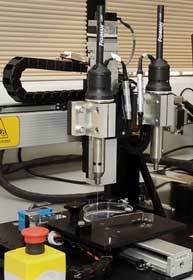 (a) |
 (b) |
(a) Bio printer and (b) model of printing a blood vessel. Image credits Organovo. |
|
The food industry uses icing, frosting, chocolate, cheese, batter, dough, or anything you can think of that you can squeeze out of a tube. 14
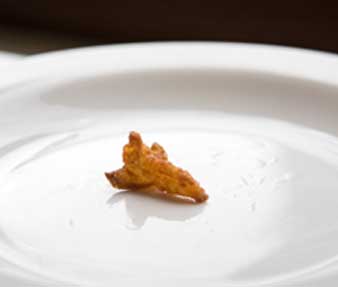 (a) |
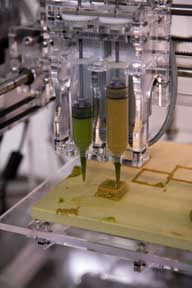 (b) |
(a) deep fried space shuttle, (b) printing a turkey with ground up turkey. Image Credits: David Arnold, photo credits Dan Cohen, Courtesy of The Creative Machines Lab at Cornell University. |
|
The Creative Machines Lab at Cornell University has been working on using multiple "inks" and has successfully printed out batteries and a working flashlight! The battery required five different materials or "inks" and those materials had to be compatible for layering. Anything that can be layered and extruded (pushed through the nozzle of the machine) can be used as "ink." That includes metals, plastics, polymers, food, cement, and more.
Fused deposition modeling, or FDM, uses melted plastics as "ink" and a controlled, moveable table-top and printhead (or deposition nozzle) that follow the instructions of the electronic input files. As the melted plastic is forced out of the printhead, the table moves down and the printhead move along the horizontal plane, placing layer upon layer of material. Some 3-D printers create disposable support structures, to assure the model is stable as it is hardening.
Some 3-D printers cure liquids with lasers to harden them where needed. In this case the "ink" is the laser light shining on the liquid to harden it. A container of liquid is moved down after a layer has been completed, and the laser lights move along the horizontal plane hardening the next layer. Another laser hardening method uses 2-photon photopolymerization and can make features up to 0.1 micron in size. That's about 100th the width of a hair! Selective laser sintering or SLS uses a high-powered laser to fuse together powdered glass, metal, plastic, or ceramics.
There are 3-D printers that create solid layers and fuse the layers together with a sealant. The inkjet type of 3D printer creates the most colors. It spreads layers of powders that are a type of plaster or resin and then inkjets spray color and a binder, as they did in making the wrench shown in the video link above.
None of these printers would work without the ability to move the printhead and table-top. The basic physics needed is energy transformation – one must convert electrical energy to mechanical energy. Motors do this. For a 3-D printer a stepper motor and/or servo-motor drives moveable table-tops and the printhead to just the right location. The fundamental property of all motors involves the interaction between electric and magnetic fields. Moving charge (electric current) creates a magnetic field, which then can interact with a permanent magnetic field. When a coil of wire with an electric current in it is near a permanent magnet, a force between the two will exist. The coil of wire, if allowed to rotate, will align itself so that the magnetic north of the field it creates lines up with the magnetic south pole of the permanent magnet. Once the magnetic fields are aligned, the coil will stop rotating; however, if the electric current is switched off, the induced magnetic field disappears and the coil will continue rotating. The idea is to turn on and off the electric current and keep the coil rotating which then can rotate a shaft and move an object (such as fan blades or the rotor of a helicopter). The motors in a 3-D printer use the same basic physics but can be controlled more precisely so they displace an object such as a printhead or a table-top to within tens of microns or 0.00001 meters.
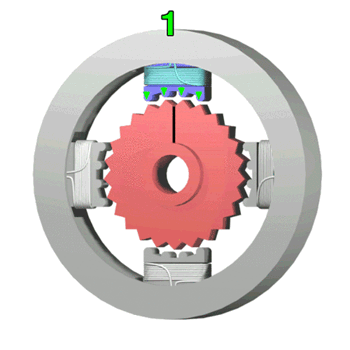 (a) |
 (b) |
(a) Stepper motor, Image Credit: WikiCommons. (b) Remote controlled servo motor showing 1. Electric motor, 2 position feedback potentiometer, 3 reduction gear, and 4 actuator arm. Image credit: WikiCommons. |
|
Stepper motors have electromagnets with "teeth" or bumps on the inside of a ring and a circular gear inside. The circular gear's teeth are slightly offset with the electromagnet, so when electromagnet 1 is turned on, the gear's teeth will line up with it, but will be slightly off-set with electromagnet 2. Then electromagnet 1 is turned off and electromagnet 2 is turned on, aligning the inner gear's teeth with electromagnet 2. This process continues, rotating the central gear, from electromagnet 1 to 2 to 3 to 4. The gear is connected to a shaft that will move an object such as a table-top. Each slight rotation is called a step. Stepper motors are often described by the integer number of "steps" it takes to go around once.
Servo motors often use a regular DC motor for transforming electrical energy to mechanical energy, but they also use a continuous feedback loop on the position to help control its location and speed. Information about the actual location is obtained and compared to the desired input location. A controller adjusts for any differences making sure that the object is to within microns of where it needs to be. The controller can also monitor speed, making sure that the object being moved does so steadily (which is important to get even layers of material).
Future research and applications
Current research includes building prosthetics, body parts such as knees, hips, arteries, bladders, and other organs, specialized tools, and robotics. Research is being conducted on using multiple inks, which requires taking into account the different properties of the inks (deposition materials) used.
Dr. Lipson of Cornell University's Creative Machines Lab, described one major goal of 3D printing as "The democratization of innovation - anyone can do this." It would open up the doors to creativity for people, just as computers have helped many create. If you have an idea for an object, you can design it, have it printed, and test it within a week. Specialized products could be made to order with no waste, reducing costs. Imagine designing your own robot, perhaps one that will walk out of the machine, with specialized motors – a polymer that contracts or expands when a voltage is applied across it. Perhaps one will design and print out specialized tools, or cakes with secret messages.
One important feature that may be very useful for space travel is the ability to print out whatever part or tool you might need, provided you have the materials for printing. You would only require the material that the object contains. Rather than carrying to space hundreds of spare parts, you bring a printer with hundreds of electronic files describing the parts, and some raw materials for constructing the parts. It is also possible to recycle old materials for printing.
References, resources, and links
1. Wikipedia Rapid Prototyping
2. Organovo Press Release, First Fully Bioprinted Blood Vessels, 8 December 2010.
3. Simonds, D., Printing Body Parts: Making a bit of me – a machine that prints organs is coming to market, The Economist, 18 Feb 2010.
4. Forgacs, G. Writer and Narrator, Weiland, C. Illustrator and Producer, Tissue Engineering, Video Missouri University (2008).
5. NPR Morning Edition, Wake Up and Smell the Pancakes,12 September 2011.
6. Lipton, J. Printing Food, Cornell Creative Machines Lab.
7. Dillow, C. Cornell Fabrication Lab Makes Edible Objects with 3-D Printer, Popular Science, 1 March 2011.
8. Olivarez-Giles, N., These 'printers' make 3-D stuff, Los Angeles Times, 29 May 2010.
9. Video of Zcorp.
10. Fab@home, the open-source personal fabrication project.
11. Ward, L., Fab at Home, Open-Source 3D Printer, Lets Users Make Anything, Popular Mechanics, 1 October 2007.
Video http://video.popularmechanics.com/services/player/bcpid1213900627?bctid=1231030451
13. Rosenblum, A. & Carnett J. B., Awesome Labs: You Call This College? Popular Science, September 2011.
14. 3D printing ,Wikipedia.
15. Stepper Motors, Wikipedia.
16. Servo Motors, Wikipedia.
17. 3D printed head.
H.M. Doss














